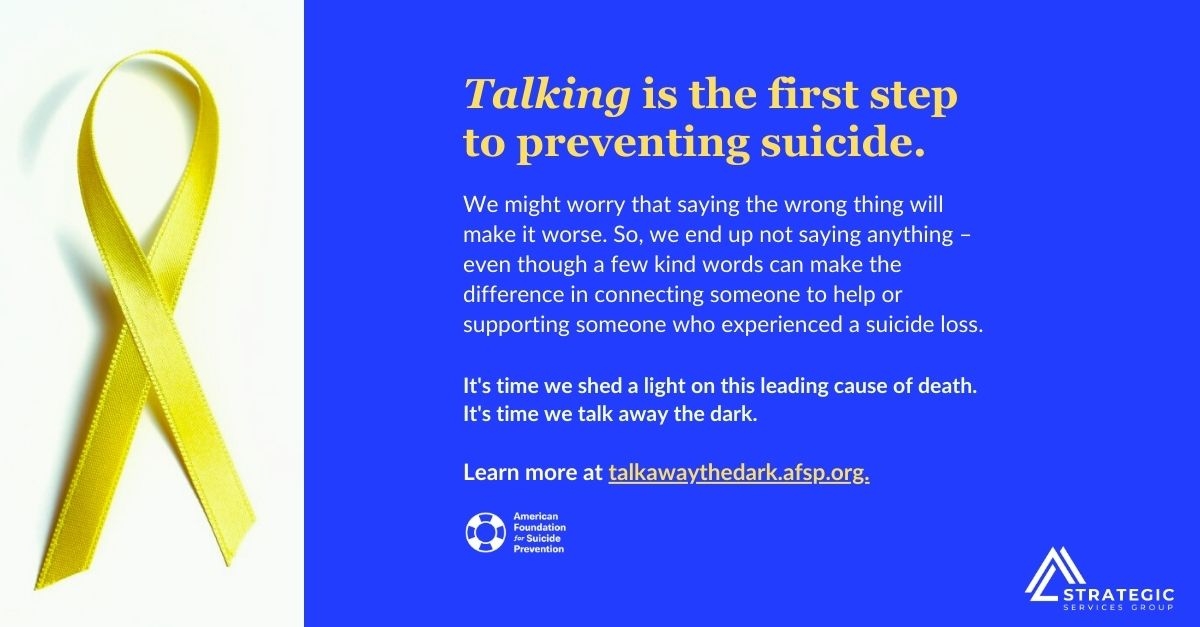Suicide Education and Prevention

Suicide is a leading cause of death for Americans, but much like mental health in general, the topic rarely gets the attention it deserves. There is a stigma against discussing suicide and mental health in the United States that hinders meaningful conversation about the topic. Open dialogue is an important part of preventing these tragic deaths and establishing safety outlets for those in need. This HR Insights examines the rise of suicide in the United States, provides general facts surrounding it and explains how employers can help curb this growing epidemic.
Understanding Suicide and Mental Health
There’s no single cause for suicide. Suicide most often occurs when stressors and health issues converge to create an experience of hopelessness and despair. Depression is the most common condition associated with suicide, and it is often undiagnosed or untreated. Conditions like depression, anxiety, and substance problems, especially when unaddressed, increase risk for suicide. Yet it’s important to note that most people who actively manage their mental health conditions go on to engage in life.
By current estimates, about 1 in 5 Americans are living with a mental illness. This dispels the idea that mental health is something that can be willed away. Chances are that you personally know someone with a mental illness or at least work with an individual who has one. It’s important that you take meaningful steps to help people with these conditions, not just pretend they do not exist. In fact, inaction is a large part of the problem.
Prevention
If someone you know is threatening suicide, it is important to start a conversation regarding his or her feelings.
Talking is the first step to preventing suicide. We might worry that saying the wrong thing will make it worse. So, we end up not saying anything – even though a few kind words can make the difference in connecting someone to help or supporting someone who experienced a suicide loss.
Most of the time, the person will talk willingly. Make sure to listen and express empathy. Do not leave him or her alone, and if he or she refuses professional help, see that a parent or trusted friend is informed.
Warning Signs
Something to look out for when concerned that a person may be suicidal is a change in behavior or the presence of entirely new behaviors. This is of sharpest concern if the new or changed behavior is related to a painful event, loss, or change. Most people who take their lives exhibit one or more warning signs, either through what they say or what they do.
Coping with Suicide
The grief associated with this act can be complex. Guilt and anger may accompany sadness if the person thinks it was possible to have prevented it. It is important to get help from a mental health professional or grief counselor, and some people find it helpful to join a support group or keep a journal.
For help and more information:
- American Institute of Suicidology www.suicidology.org
- National Institute of Mental Health www.nimh.nih.gov/health/topics/suicide-prevention/index.shtml
- Centers for Disease Control and Prevention www.cdc.gov/violenceprevention/suicide/
- Department of Veterans Affairs www.mentalhealth.va.gov/suicide_prevention/index.asp
What Employers Can Do
Companies cannot expect employees with mental illnesses to simply “snap out of it” or wipe away thoughts of self-harm. Employers need to acknowledge that mental illness comes in many forms and that it probably affects more of their employees than they know. This is why employer-sponsored assistance programs are so important.
Employers should foster a safe environment that encourages employees to speak up if they’re feeling overwhelmed by work, as this is a significant stressor for depression and other mental illnesses. Beyond reassessing company culture, organizations can offer referrals or access to mental health professionals through their Employee Assistance Program (EAP). One of the most effective ways to reduce suicide is by being there for someone in need. With this in mind, consider empathy training for managers so they can recognize the warning signs of severe depression and can address them with the individual.
Resources for Employers
Anyone can access this information, but, as an employer, you have the opportunity to proactively share these links with employees. Take a look at the links provided below and consider sending an email or hosting a meeting to discuss this serious topic.
- “Preventing Suicide: A Technical Package of Policy, Programs, and Practices” www.cdc.gov/violenceprevention/pdf/suicideTechnicalPackage.pdf
- Important information about suicide in the United States www.cdc.gov/vitalsigns/suicide
- American Foundation for Suicide Prevention (AFSP) Prevention Resources https://afsp.org/suicide-prevention-resources/
- The Depression and Bipolar Support Alliance www.dbsalliance.org
- The National Suicide Prevention Lifeline: www.suicidepreventionlifeline.org
- https://www.crisistextline.org/
- 988 Suicide & Crisis Lifeline

 Prev
Prev

